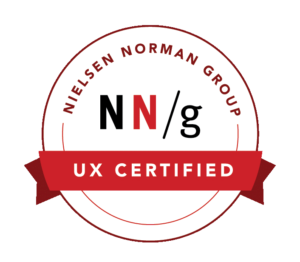There are so many different facets of user experience (UX), and anyone who claims to be a ‘specialist’ in all of them is either lying, or doesn’t understand how broad the term ‘UX’ is. My focus is on UX testing – I’m not, first and foremost, a designer.
Find out more about the areas where I provide UX consulting below, along with some indicative rates.
My Services
You can hire me to:
- Run a discovery workshop
- Guide you through a content inventory & audit
- Facilitate and provide actionable insights from card sorting
- Create research questions and testing tasks for tree-testing or usability testing
- Facilitate tree-testing or usability testing
The amount of work involved in any and all of these differs greatly depending on the scope of the project. Workshop facilitation starts at $200 + GST per hour, plus preparation time and collation of the results into deliverables. If you think that working with me might help your organisation, book an obligation-free 15 minute Zoom call below.
Why Me?
Nielsen Norman Group (NN/g) is the world’s leading training organisation in research-based user experience. Their certification is intensive and rigorous, and less than fifty individuals in Australia gain their UX certification each year. I’ve completed over 30 hours of dedicated UX training to achieve my certification, and I’m now working towards my Master specialising in UX Research and Interaction Design.
You can find me in the Nielsen Norman Group UX Certified People directory by searching ‘Jo Minney’ or my certification ID 1054038.
Discovery
The discovery phase of a project is exploratory, which basically means… messy. The purpose of a discovery phase is to achieve consensus on the problem that you are trying to solve, and the desired outcomes. More broadly, it is the phase of a project where we condense and refine the ideas and challenges into an evidence based plan for the future.
The discovery process is often predominantly internal, but there are certain aspects that can benefit from having an external facilitator – in particular, workshops designed to collect lots of information from out of a variety of people’s heads. Having an qualified external facilitator reduces the chance that internal politics or pre-existing assumptions are going to negatively influence the outcome of the workshop.
Research Question Generation Workshop
Also referred to as ‘Assumption-mapping workshops’, in this type of workshop, data gathering is conducted to identify the validity of ‘facts’ and deep-rooted assumptions that could de-rail your project. This can be a valuable activity prior to usability testing, as identifying assumptions can help to define research questions that will provide useful feedback. We’ll also explore what your ‘unknowns’ are, and draft research questions that will drive future research efforts.
User Mapping Workshops
This type of workshop is typically used to identify how a user (or group of users) interact with a product or service. There are a range of different types of discovery maps, including user journey maps, process maps, and ecosystem maps.
Information Architecture
Have you ever gone to a website and struggled to find something you know is there? This might be an example of poor information architecture at work!
Specifically, information architecture deals with the content and relationships between bits of content on a site. It includes things like your site map, how content is stored in a database, and what labels you might use to group different chunks of content.
Content Inventory & Audits
The first step in creating or overhauling a site is to identify what content you have vs what content you need. Following a structured process, I’ll guide you through generating a comprehensive inventory of all of your content ‘chunks’, and making a plan for what needs to be kept, updated, split, merged or trashed.
Card Sorting
Card Sorting is a UX research method where study participants group individual labels (representing ‘chunks’ of content) in a way that makes sense to them. The goal of it is to uncover the users’ mental models, in order to better understand how to organise your content. While super powerful, card sorting is often expensive and always time-consuming. Check out this blog post on my suggested approach to card sorting!
Tree Testing
Tree Testing is how you work out whether or not your navigation labels actually make sense to your users. Tree testing can be conducted qualitatively with a small number of users, to test whether or not your information hierarchy and structure can be navigated to find key bits of information. Tree testing can also be conducted quantitatively (using a large number of tests and collating statistical data to determine what does and doesn’t work).
Usability Testing
In my professional opinion, usability testing is one of the most cost-effective and actionable research methods available. During a usability test, participants (usually between four and six of them, but one at a time) are asked to perform a series of tasks on a site or prototype, while explaining what they are doing to a facilitator. To conduct a good usability test, you must:
- ensure that your tasks are structured in a way that doesn’t lead the participant or introduce bias while still answering your research questions, and;
- ensure that the facilitator doesn’t interfere with the task being performed. It’s harder than it sounds!
Usability tests can be conducted with nothing more than a screensharing tool, with no fancy software required.

